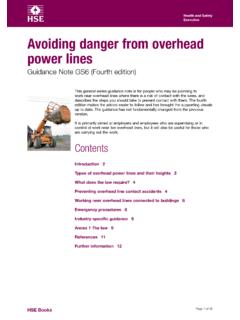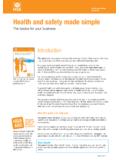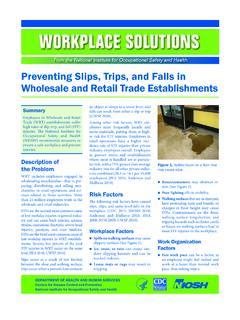Transcription of ‘Struck-By’ Hazards
1 FOCUS 4. CONSTRUCTION SAFETY & HEALTH. struck -By' Hazards Participant Guide This material was produced under grant number SH-16586-07-06-F-36 from the Occupational Safety and Health Administration, Depart- ment of Labor. It does not necessarily reflect the views or policies of the Department of Labor, nor does mention of trade names, commercial products, or organizations imply endorsement by the Government. SECTION #2. struck -By Hazards Being struck by an object is one of the leading causes of construction-related deaths. Workers are most often struck by: heavy equipment and vehicles, likes trucks and cranes;. falling or flying objects, like tools and flying particles;. concrete or masonry walls that are being constructed Employers must protect workers from being struck by vehicles and objects on the job.
2 While these Hazards exist, there are ways to prevent or reduce injuries from these types of Hazards . These are called control measures, and workers must ensure that control measures are in place to ensure their safety. Tool Safety: Picture shows the movable lower guard of this circular saw in its fully raised Crane Safety: Can the crane operator see you? Stay out of the position and with the blade fully exposed below swing radius of the cab and of the load and never get under the base plate. a suspended load. prevent kick-back of the saw by adjusting the blade exposure to the minimum distance needed, with saw teeth extending just beyond the thickness of the material you are cutting. Tool Safety: Always make sure the head of the Unsafe Work: You must cap the ends of exposed rebars hammer is firmly attached to the handle so the (reinforcing bars) if anyone can walk into them or fall onto them.
3 Head doesn't fly off. SECTION #2 | Participant Guide 1 struck -By Hazards mEXERCISEm Controlling struck -By Hazards Divide the group into three smaller groups. Each group must come up with answers on how to control the Hazards they are assigned. 1. HAZARD: VEHICLES HOW DO WE WORK SAFELY? (Control Measures). 1. Driving a vehicle at work 2. Driving a vehicle that is not properly maintained 3. Driving vehicle in reverse gear 4. Parking on an incline 5. Using lifting or dumping devices 6. Carrying / lifting heavy loads 7. Operating powered industrial trucks (forklifts). 8. Working on public roadways GENERAL: WEAR HARD HATS. STACK AND SECURE MATERIALS TO prevent SLIDING. OR COLLAPSE. SECTION #2 | Participant Guide 2 struck -By Hazards 2.
4 HAZARD: FALLING/FLYING HOW DO WE WORK SAFELY? (Control measures). OBJECTS. 1. Working underneath cranes, hoists, scaffolds 2. Performing overhead work 3. Working with hand tools 4. Working with power tools, such as saws, drills, grinders 5. Working with machines, such as jack hammers, pavement saws 6. Working with powder-actuated tools 7. Pushing or pulling objects that may become airborne 8. Working with compressed air SECTION #2 | Participant Guide 3 struck -By Hazards 3. HAZARD: CONSTRUCTING MASONRY HOW DO WE WORK SAFELY? (Control Measures). AND CONCRETE WALLS. 1. Placing construction load on concrete structure 2. Working when permanent support elements are still not in place 3. Having unauthorized persons working in area 4. Loading lifting devices with heavy materials 5.
5 The lifting device fails and falls on the structure you are building SECTION #2 | Participant Guide 4 struck -By Hazards mSUMMARYm struck -by Hazards Vehicles, Falling and Flying Objects, and Masonry Walls Too many construction workers die on the job when they are 1. struck by a vehicle;. 2. struck by a falling or flying object;. 3. struck by a concrete or masonry wall that collapses. To prevent injury or death from being struck BY A VEHICLE: 1. Wear a seat belt! Seat belts save lives, both on the roadways and on construction sites. (Note: Don't wear one if the vehicle is only designed for standing up or if it has no rollover protective structure, like a roller used on paving jobs.). 2. Make sure that all vehicles are inspected before each shift everything should be in good working condition, including the brakes, before you begin work.
6 Use your parking brake when the vehicle is not in use, and chock the wheels if you are parked on an incline. And never lift or load more than the vehicle can hold. 3. If you are driving a vehicle in reverse and you can't see behind you, be sure to have a reverse alarm that people can hear, AND have another worker signal to you that all is safe. Ensure that no one is in the way when you are using lifting and dumping devices. Get out and look for people and Hazards . 4. Don't drive vehicles in areas that are not safely constructed or maintained. When using lifting or dumping devices, make sure to clear all personnel and lower or block all blades. 5. All forklift operators must be trained and certified. Equipment must be inspected, and all safe operating procedures must be followed.
7 Drive slowly, and don't travel with elevated loads. Make sure all signal alarms work, and watch for hazardous conditions (involving both workers and objects). 6. If you are working in traffic, use traffic signs and barricades. Use flaggers if needed. Be sure to stay out of blind spots. Workers must wear warning clothing, like orange vests. If they are working at night, these must be of a reflective material. Use proper lighting when working at night. Use traffic barricades whenever possible. If you can't barricade the traffic, use heavy equipment with impact attenuators (crash cushions) within the work zone, to protect you from moving traffic. Be alert for pedestrians in urban areas. To prevent injury or death from FALLING or FLYING OBJECTS: 7.
8 Inspect tools, cranes, hoists to see that all are in good condition. 8. Use toeboards, screens, debris nets, and guardrails on scaffolds to prevent tools/other items from falling from overhead work areas. SECTION #2 | Participant Guide 5 struck -By Hazards 9. If you are working underneath cranes, hoists or scaffolds, never work under a suspended load. Barricade hazard areas and post warning signs. Don't exceed capacity, and don't assume the operator has seen you. Watch out for power lines, unstable soil, and high winds. 10. Materials stored shall not be placed within 6 feet of hoist way/floor openings, nor within 10. feet or an exterior wall which doesn't extend above material. 11. Don't use hand tools with loose, cracked or splintered handles, or use impact tools with mushroomed heads; the head could fly off, striking you or others.
9 Operators of powder- actuated tools (gunpowder) must be trained and licensed. Train all workers on safe operation of tools, and inspect all tools before use. 12. Train workers on safe operation of power tools, such as saws, drills, and grinders. Inspect all tools before use, and wear protective gear. Guard rotating and moving parts all guards must be in place when tools are in use. 13. Secure tools and other items to prevent them from falling on the people below; stack and secure materials (even from wind gusts) to prevent sliding, falling or collapse. And always keep areas clear of clutter. 14. Use personal protective equipment to prevent being hit by falling or flying objects. Wear a hard hat, safety glasses, goggles, and face shields.
10 Wear hearing protection when needed. 15. Reduce compressed air used for cleaning to 30 psi, and only use it with the proper guards and other protective equipment. And never clean your clothing with compressed air: you could be injured by a particle driven into your eyes or skin by the force. Workers are killed or are seriously injured when they are BUILDING CONCRETE OR MASONRY. WALLS. They can be struck by materials when the lifting equipment is putting the slabs in position, or when materials are not shored properly and are not yet stable. To prevent these types of accidents: 16. Don't place loads on concrete structures until someone who is qualified says that it's safe to do. 17. Shore structures until permanent supporting elements are secured; concrete should be tested to make sure it has enough support strength.















